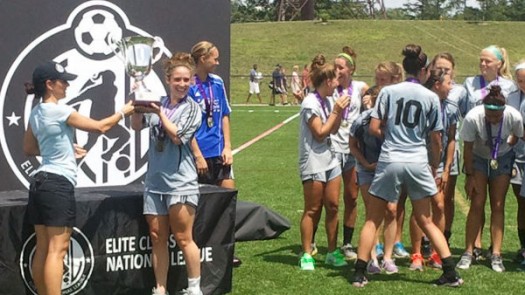Dure: If you must cut players, consider the options
 Yes, I’ve lampooned the practice of winning youth soccer trophies through collecting talented players. And yes, Dr. Wendy LeBolt has introduced us to a terrific, dedicated youth soccer coach who doesn’t cut players.
Yes, I’ve lampooned the practice of winning youth soccer trophies through collecting talented players. And yes, Dr. Wendy LeBolt has introduced us to a terrific, dedicated youth soccer coach who doesn’t cut players.
But can anyone make an argument for assembling a youth soccer roster like it’s a pro team? Apparently so:
Recruiting and cutting players is an integral and critical part of player development.
— 3four3 (@3four3) March 26, 2015
Gary Kleiban, a member of the 3four3 coaching group that has built a reputation as one of the nation’s best, goes on to clarify that he’s talking about non-recreational youth soccer above Under-10. No one’s suggesting that the U-8 Purple Butterflies need to cut the kid who missed the sitter right in front of the Pugg goal.
But at older age groups and at levels of competition above your local rec league, “to cut or not to cut” is a tough question with a few legitimate pros and cons to weigh against each other.
 Competition can indeed teach life lessons. And the further we go down the “everybody gets a trophy” helicopter-parenting route (though the more precise term in this case is “snowplow parenting”), the more we dilute those lessons and leave kids unprepared for the disappointments we adults simply can’t avoid: breakups, not getting into a first-choice college, not getting that awesome job, maybe even having kids who lack the interest or the aptitude to be an elite athlete.
Competition can indeed teach life lessons. And the further we go down the “everybody gets a trophy” helicopter-parenting route (though the more precise term in this case is “snowplow parenting”), the more we dilute those lessons and leave kids unprepared for the disappointments we adults simply can’t avoid: breakups, not getting into a first-choice college, not getting that awesome job, maybe even having kids who lack the interest or the aptitude to be an elite athlete.
Another benefit to finding the best of the best: Elite competition and training can help players reach their potential. We think. We hope. At the very least, we’d have to think players who really want to play and be challenged should have the opportunity to get a different experience than the kids who are just running around because their parents want them to get some exercise.
So cutting players, maybe through annual tryouts, has some benefits. Does it outweigh the drawbacks?
+READ: LeBolt: How to build a successful travel team without ever cutting a player
The questions to ask would include:
1. How young is too young? Do you tell a 7-year-old player that he can’t play on your team because he’s not as good as another 7-year-old player? What if the first player was born 10 months after the second? What, exactly, are you projecting here? We can’t even tell which players are going to be great pros at age 17 — look at Brazil’s 2003 U-17 world champions and see which names jump out at you — so what makes us think we can to do it at age 7?
2. What opportunities are left for the players who are “cut”? How are you going to train those kids who haven’t grown into their bodies at U-10 but blossom in their teens?
+READ: Dure: Machiavelli’s guide to winning in youth soccer
Germany, the current trendy beacon of proper youth development, sends federation coaches all over the country to work not just with pro academy trainees but everyday junior players, and a club like Freiburg keeps younger players at arm’s length before bringing in the top players for a healthy mix of soccer and school.
Other successful youth programs simply don’t cut players until they’re almost adults. Iceland, which punches well above its weight class in soccer (and handball), keeps clubs open to anyone up to age 18. Top Swedish hockey club Skelleftea churns out elite players without cutting kids before age 17.
One advantage of this approach: All of these players stay within the club. You don’t turn away players at age 9 and let someone else coach them, then try to integrate them back into your club at age 14 because another kid moved, quit or simply didn’t pan out.
In other words: The best available players at U-9 often aren’t the best available players at U-16. So who’s developing them in those intervening years? If those development years are so crucial, why are you turning them over to someone else?
And that brings us back to recruiting. If you keep a large pool of players, why do you need to recruit? Players might move in and out of your top group, but you can guide them all to maximize their potential.
+READ: Dure: Did U.S. soccer structure fail Freddy Adu?
Recruiting is also one of the things that gives youth soccer — along with some other youth sports — a bad name. Parents are horrified when coaches wander up to them and ask them — or their teammates — to change clubs. It turns soccer into a bitter world of politics and recriminations. No wonder kids quit.
And the bulk of recruiting as we know it merely shifts a player from one half-decent club to another. That helps the coach, not the player. To recruit, you win. To win, you recruit. Development isn’t part of that equation.
 But there’s a place in the soccer community for elite clubs (or elite teams within clubs) that play in selective leagues. In a well-informed soccer community, these clubs are selecting rather than recruiting. (And scouting — if you’re running a youth-centric Premier League club like Southampton and happen to find a Gareth Bale on a forlorn youth field, that’s a little different than simply poaching your neighbor’s talented players.)
But there’s a place in the soccer community for elite clubs (or elite teams within clubs) that play in selective leagues. In a well-informed soccer community, these clubs are selecting rather than recruiting. (And scouting — if you’re running a youth-centric Premier League club like Southampton and happen to find a Gareth Bale on a forlorn youth field, that’s a little different than simply poaching your neighbor’s talented players.)
Which brings us back to tryouts and cuts. Surely some choices have to be made somewhere. Clubs only have so many resources — staff, fields, etc. And if you want to get your club’s top players challenging each other and the top players from other clubs, someone will be left out.
When that’s done, how that’s handled and what other opportunities are presented will go a long way toward developing young people as soccer players and human beings.
SOCCERWIRE MARKETPLACE
- FC Bayern Soccer Camps - $30 PROMO CODE: BMSOCCERWIRE
- Real Colorado Cup 2026
- Join a College Coaches Showcase Camp Today
- MICFootball Punta Cana 2026
- Dana Cup Hjørring 2026
- 15th Annual Loudoun Soccer College Showcase
- OFFICIAL FC BARCELONA SOCCER CAMPS - PROMO CODE: FCBSOCCERWIRE
- New England Copa Surf 2026
- Adidas National Cup 2026
- Boston International Cup Memorial Day 2026
College Recruiting Commitment Tracker
Featured Players
COLLEGE RECRUITING STARTS HERE
Join the SoccerWire College Soccer Recruiting Search Engine and learn how to be seen OVER 1 MILLION TIMES PER YEAR.
- Basic $99 – for life
- Featured $299 – for life
- Featured PLUS $399 – for life











